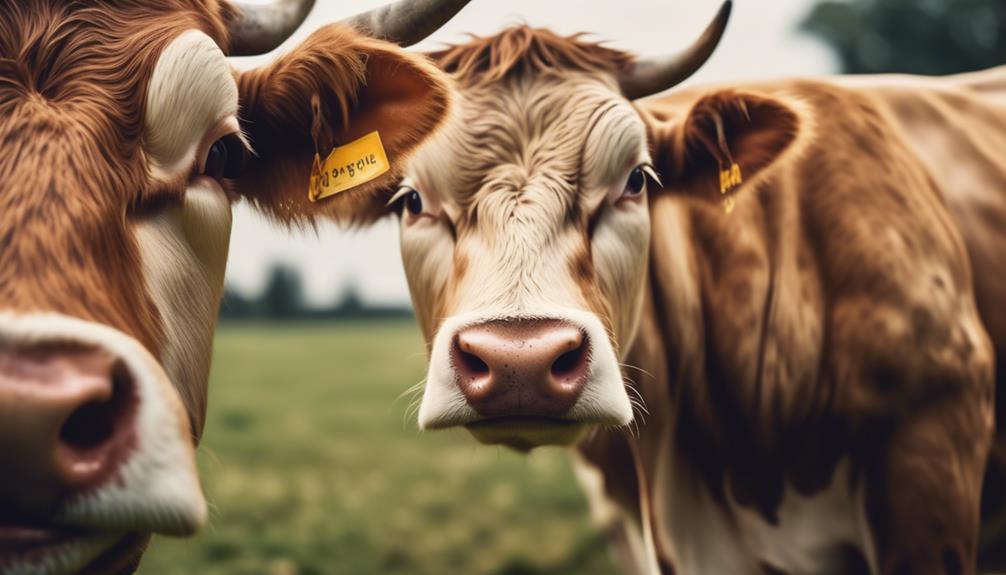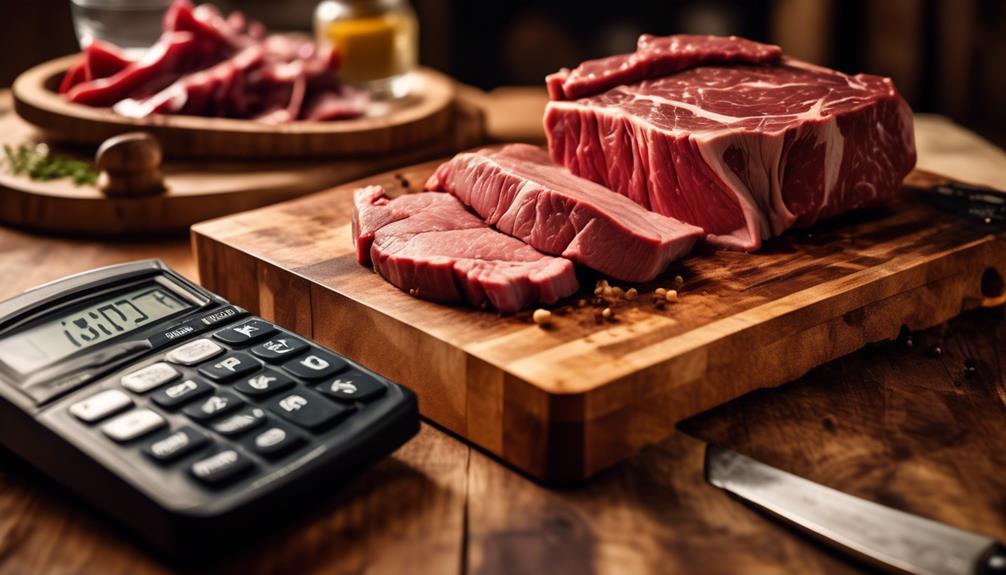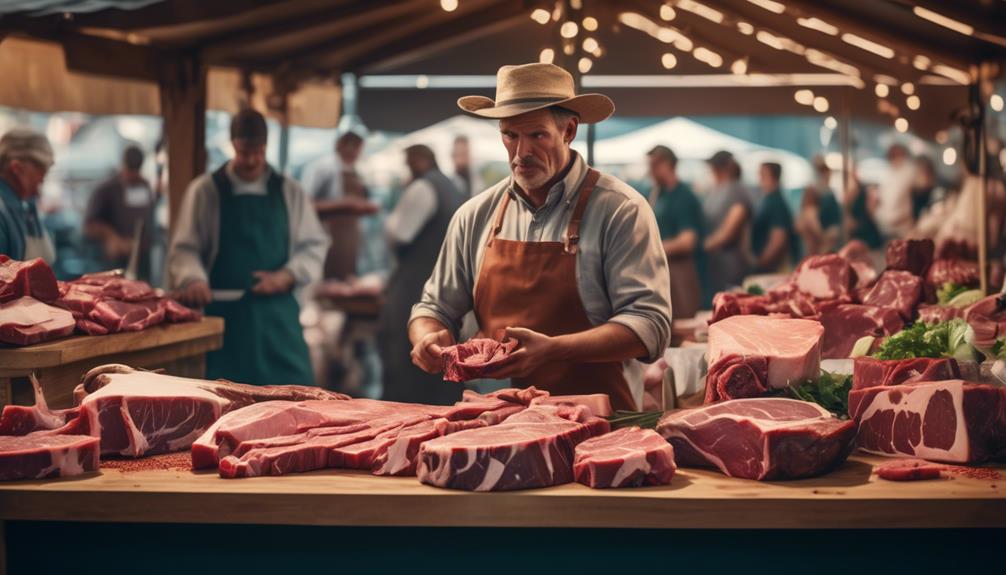When it comes to purchasing a whole cow, there are several factors that can influence its cost. From the breed of the cow to its weight, as well as market conditions and additional costs, it is essential to understand the various elements that contribute to the final price. Furthermore, knowing where to buy a whole cow and how to budget and negotiate effectively can make a significant difference in the overall cost. In this discussion, we will explore these factors in detail, shedding light on the intricacies of pricing and offering valuable tips to help you make an informed decision. So, if you've ever wondered about the cost of a whole cow, keep reading to unravel the answers.
Key Takeaways
- The breed of the cow plays a significant role in determining its market value, with certain breeds like Angus and Brahman known for superior meat quality.
- The weight of the cow affects its cost, with heavier cows generally being more expensive. Factors such as breed, age, and feeding regimen influence the weight of the cow.
- Various factors impact the overall cost of a cow, including breeding selection, transportation costs, age, health, and market conditions.
- Market conditions, such as supply and demand dynamics, greatly influence cow prices. Excess supply leads to price decrease, while limited supply leads to price increase. Understanding market trends is crucial in making informed purchasing decisions.
Factors Affecting Whole Cow Prices

The price of a whole cow is influenced by various factors that encompass market dynamics, supply and demand trends, and economic conditions. One of the key factors that plays a significant role in determining the cost of a whole cow is the breed of the animal. Different breeds of cows have distinct characteristics that affect their market value. For instance, certain breeds are known for their superior meat quality, while others are valued for their milk production. These breed-specific attributes contribute to variations in prices across the market.
Another crucial factor impacting the cost of a whole cow is its weight. Generally, there is a positive correlation between the weight of the cow and its price. Heavier cows tend to yield more meat, leading to higher prices. Additionally, larger cows often require more resources and care, which further influences their market value. However, it is important to note that the weight and price correlation may vary based on other factors, such as breed and market demand.
Market demand also plays a significant role in determining the price of a whole cow. If there is a high demand for beef products, the prices of whole cows are likely to increase due to limited supply and increased competition among buyers. Conversely, if the demand is low, prices may decrease as producers try to sell their livestock.
The Role of Breed in Cow Pricing
Different cow breeds play a crucial role in determining the market value and pricing of whole cows due to their distinct characteristics and attributes. The role of genetics and breed popularity significantly influence the final price of a cow in the market. Farmers and buyers consider a variety of factors when determining the value of a cow, including breed, size, age, weight, and overall health.
The table below illustrates the average prices of some popular cow breeds in the market:
| Breed | Average Price (per cow) |
|---|---|
| Angus | $1,800 – $2,500 |
| Hereford | $1,500 – $2,000 |
| Holstein | $1,200 – $1,800 |
| Brahman | $1,800 – $2,500 |
| Limousin | $2,000 – $2,500 |
Angus and Brahman breeds are known for their superior meat quality and are highly sought after in the market. This demand contributes to their higher market value compared to other breeds. Hereford and Holstein, on the other hand, are popular for both meat and dairy production, which makes them appealing to a wider range of buyers. Limousin, known for its excellent meat yield and tenderness, also commands a higher price due to its desirable characteristics.
While breed popularity and genetic factors are significant determinants of a cow's price, it is important to consider other factors such as age, weight, and overall health. Younger cows with higher weights and better health tend to fetch higher prices in the market.
Understanding the Impact of Weight on Cow Cost

The weight of a cow plays a significant role in determining its cost. Generally, there is a positive correlation between weight and price, meaning that heavier cows tend to be more expensive. Several factors can influence the weight of a cow, including breed, age, and feeding regimen. Understanding these factors and their impact on weight can help farmers and buyers make informed decisions when it comes to purchasing or selling cows.
Weight and Price Correlation
Understanding the relationship between weight and price is crucial when determining the cost of a whole cow, as it allows for a more accurate and informed assessment of its market value. The average weight of a cow can vary depending on the breed and age. For example, a mature Angus cow can weigh around 1,200 to 1,500 pounds, while a Holstein cow can weigh around 1,500 to 1,800 pounds. The price per pound of the cow also varies based on factors such as demand, quality, and location. Below is a table illustrating the weight and price correlation for different cow breeds:
| Cow Breed | Average Weight (lbs) | Price per Pound ($) |
|---|---|---|
| Angus | 1,200-1,500 | 3.50-4.50 |
| Hereford | 1,200-1,400 | 3.00-4.00 |
| Holstein | 1,500-1,800 | 2.50-3.50 |
Factors Affecting Cow Cost
Correlating the weight of a cow with its market value is essential in determining the factors that affect the cost of a whole cow. When it comes to understanding the impact of weight on cow cost, several key factors come into play:
- Breeding selection: The genetics of a cow play a significant role in its weight and size. Breeding programs that focus on producing larger and heavier cows will generally result in higher costs.
- Transportation costs: The distance and mode of transportation can greatly influence the cost of a whole cow. Long-distance transportation or specialized transportation methods, such as refrigeration trucks, can add to the overall cost.
Market Conditions and Their Influence on Cow Prices
Market conditions play a pivotal role in shaping the prices of cows, as they directly influence the supply and demand dynamics of the industry. Understanding the market trends and the factors that drive them is crucial for anyone looking to purchase a whole cow. Let's take a closer look at how market conditions impact cow prices.
One of the key factors in determining cow prices is the supply and demand balance in the market. When the supply of cows exceeds the demand, prices tend to decrease, as sellers look to offload their inventory. Conversely, when the demand for cows surpasses the supply, prices tend to rise, as buyers compete for limited resources. This relationship between supply and demand creates volatility in cow prices and reflects the overall market conditions.
To further illustrate the influence of market conditions on cow prices, let's examine a table showcasing price fluctuations over the past year:
| Month | Average Cow Price ($) | Market Conditions |
|---|---|---|
| January | 1,200 | High demand, limited supply |
| April | 1,000 | Balanced supply and demand |
| July | 800 | Increased supply, decreased demand |
| October | 900 | Slight increase in demand, stable supply |
As seen in the table, the average cow price fluctuates based on the prevailing market conditions. Understanding these trends can help buyers make informed decisions about when to purchase a whole cow and at what price.
Additional Costs to Consider When Buying a Whole Cow

The cost of purchasing a whole cow extends beyond just the fluctuating prices influenced by market conditions, as there are additional expenses that buyers need to take into account. While the price per pound or the total cost of the cow itself is an important consideration, it is equally important to factor in the following additional costs:
- Transportation fees: When buying a whole cow, one must consider the costs associated with transporting the animal from the farm to the processing facility or butcher. Transportation fees can vary depending on the distance traveled and the mode of transportation used. It is essential to obtain quotes from different transporters to ensure the most cost-effective option.
- Processing fees: Once the cow reaches the processing facility or butcher, there will be fees for slaughtering, butchering, and packaging the meat. These processing fees can vary depending on the services required and the facility chosen. It is important to inquire about these fees beforehand to avoid any surprises.
- Storage and freezing costs: After the cow has been processed, there may be additional costs associated with storing and freezing the meat. If you do not have adequate freezer space at home, you may need to rent freezer space or invest in additional freezer units to store the meat properly.
- Cutting and wrapping fees: Depending on your preferences, you may want the meat cut and wrapped in specific ways. Some butchers may charge additional fees for custom cuts, special packaging, or adding seasonings. It is important to discuss these details with the butcher and understand any extra costs involved.
- Delivery fees: If you are unable to pick up the meat yourself, you may need to arrange for delivery. Delivery fees can vary depending on the distance traveled and the delivery service used. It is advisable to compare different delivery options and their associated costs before making a decision.
Considering these additional costs is essential for buyers to have a comprehensive understanding of the total expenses involved in purchasing a whole cow. By factoring in transportation fees, processing fees, storage and freezing costs, cutting and wrapping fees, and delivery fees, buyers can make informed decisions and budget accordingly.
Where to Buy a Whole Cow and Potential Price Differences
One crucial aspect to consider when purchasing a whole cow is the selection of where to buy, as this decision can potentially result in price differences. Understanding the buying options available and regional price variations is essential for making an informed decision.
When it comes to buying a whole cow, there are a few options to consider. One option is to purchase directly from a local farmer or rancher. This can often provide a higher level of transparency and assurance regarding the quality and source of the meat. Another option is to buy from a local butcher or meat market, which may offer convenience and a wider range of cuts and processing options. Lastly, some consumers opt to purchase through online platforms or specialty meat suppliers, which can provide access to a wider selection of breeds and cuts.
Price variations for whole cows can be influenced by several factors, including regional differences in supply and demand, transportation costs, and local market conditions. For example, purchasing a whole cow in a rural area where there is a surplus of cattle may result in lower prices compared to urban areas with higher demand. Additionally, transportation costs can play a significant role, as shipping a whole cow over long distances can increase the final price.
To get the best deal, it is advisable to compare prices from different sources and consider the overall value provided. This includes factors such as the quality of the meat, additional services offered (such as processing and packaging), and any additional costs associated with transportation or delivery. By researching and understanding the buying options and regional price variations, consumers can make an informed decision that meets their specific requirements and budget constraints.
Tips for Budgeting and Negotiating When Purchasing a Whole Cow

When purchasing a whole cow, it is important to have a well-planned budget and effective negotiation strategies in order to maximize value and ensure a favorable deal. Here are some budgeting tips and negotiation strategies to help you navigate the process:
- Research the market prices: Before setting your budget, it is crucial to research the current market prices for whole cows. This will give you a baseline understanding of the average cost and help you determine a reasonable budget.
- Consider additional costs: In addition to the cost of the cow itself, there may be additional costs involved, such as processing fees or transportation expenses. It is important to factor these costs into your budget to avoid any surprises later on.
- Set a realistic budget: Based on your research and financial situation, determine a realistic budget for purchasing a whole cow. Consider your needs and preferences, as well as any financial constraints you may have.
- Negotiate with suppliers: When dealing with suppliers, don't be afraid to negotiate. Ask for discounts or explore the possibility of bulk purchasing to secure a better deal. Be prepared to walk away if the price does not align with your budget.
- Explore alternative purchasing options: Consider alternative purchasing options, such as buying in partnership with others or joining a meat CSA (Community Supported Agriculture). These options can help you save money by sharing the cost and resources with others.
Frequently Asked Questions
Can I Purchase a Single Cut or Portion of a Cow Instead of Buying the Entire Animal?
When it comes to purchasing options for beef, individuals often wonder if they can buy a single cut or portion of a cow instead of the entire animal. This choice can offer several benefits, especially for those who prefer variety or have limited storage capacity. However, buying in bulk, such as a whole cow, can be a cost-effective option as it eliminates middlemen and allows for better pricing. It is important to consider personal preferences, storage capacity, and budget when deciding between purchasing options.
Are There Any Legal Restrictions or Regulations I Should Be Aware of When Buying a Whole Cow?
When buying a whole cow, it is important to be aware of the legal restrictions and regulations in place. These regulations vary by jurisdiction and may pertain to issues such as animal welfare, food safety, and labeling requirements. Additionally, it is worth considering whether purchasing a single cut or portion of a cow aligns with your specific needs and preferences. By understanding and complying with these regulations, buyers can ensure a safe and compliant purchase.
How Do I Calculate the Approximate Weight of a Whole Cow?
When estimating the weight of a whole cow, there are several factors to consider. These include the breed of the cow, its age, and its body condition. One common method is using a weight tape, which measures the circumference of the cow's heart girth. This measurement is then used in a formula specific to the breed to estimate the weight. Another approach is to use a weigh scale, where the cow is weighed directly. Both methods provide an approximate weight calculation for a whole cow.
What Are Some Factors That Can Affect the Taste and Quality of Meat From a Whole Cow?
Factors such as the animal's breed, diet, age, and handling practices can significantly impact the taste and quality of meat from a whole cow. The breed determines the inherent flavor and tenderness of the meat, while the animal's diet can influence its fat content and marbling. Age affects the meat's tenderness, with younger animals generally producing more tender meat. Proper handling, including stress-free transportation and humane slaughter, also plays a crucial role in preserving the meat's quality.
Are There Any Special Considerations I Should Keep in Mind When Transporting a Whole Cow After Purchase?
When transporting a whole cow, it is crucial to consider the logistics and best practices involved. Ensuring proper handling, temperature control, and safety measures are essential to maintain the quality and freshness of the meat. Attention to detail in packaging, storage, and transport arrangements can optimize the condition of the product upon delivery. By adhering to industry standards and implementing efficient transport procedures, the chances of maintaining the integrity of the meat are maximized, leading to satisfied customers and successful business operations.
Conclusion
In conclusion, the cost of a whole cow is influenced by various factors such as breed, weight, market conditions, and additional costs. Breed plays a significant role in determining the price of a cow, with certain breeds commanding higher prices due to their quality and characteristics. Weight also affects the cost, as heavier cows generally cost more. It is important to consider market conditions and potential price differences when buying a whole cow. Additionally, budgeting and negotiating skills can help ensure a fair price.

